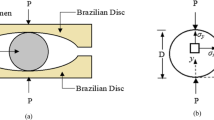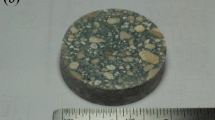Abstract
The paper is concerned with an investigation into the effect of testing techniques on the behaviour of plain concrete specimens under increasing uniaxial compressive load. It is found that for load increasing to the maximum level that can be sustained by the specimen, specimen behaviour is essentially independent of testing technique effects. However, for load levels beyond this peak level, the testing technique effects are found to be significant such that, if they can be completely eliminated, a more realistic description of post-peak specimen behaviour may be a complete and immediate loss of load-carrying capacity as soon as the peak load is exceeded.
Résumé
Des essais sur cylindres de béton en compression uniaxiale par les techniques ordinairement utilisées—qui déterminent à différents degrés des actions négatives de frottement aux surfaces sous charge—ont fait apparaître des relations contraintes longitudinales/déformation et charge/déplacement qui présentent des branches ascendantes et descendantes.
On a constaté que la branche ascendante de ces relations était absolument indépendantes de la technique d'essai, et l'on considère qu'un tel comportement indique que cette partie des relations mentionnées est de nature à donner une description vraie du comportement du béton en tant que matériau soumis à une contrainte croissante jusqu'à la rupture.
D'autre part, on a observé que la branche descendante montre une dépendance marquée de la technique d'essai. Cette branche se caractérise en ce qu'elle présente une pente beaucoup plus forte à mesure que les actions de frottement imposées par la technique d'essai diminuent. Un tel comportement indiquerait que si des actions négatives de frottement sont éliminées, le cylindre subira une perte complète et immédiate de capacité portante dès le dépassement de la charge maximale que l'éprouvette peut endurer. On peut donc admettre par conséquent qu'une perte complète et immédiate de capacité portante pour des valeurs de contrainte au-delà de la résistance à la rupture propose actuellement la description la plus juste du comportement du béton au-delà de la résistance à la rupture.
Similar content being viewed by others
References
Barnard P. R.—Researches into the complete stress-strain curve for concrete, Magazine of Concrete Research, Vol. 16, No. 49, December 1864, pp. 203–210.
Ahmad S. H., Shah S. P.—Complete stress-strain curve of concrete and nonlinear design, CSCE-ASCE-ACI-CEB International Symposium on Nonlinear Design of Concrete Structures, University of Waterloo, Ontario, Canada, August 7–9, 1979, pp. 61–81.
Kotsovos M. D., Newman J. B.—A mathematical description of the deformational behavior of concrete under generalised stress beyond ultimate strength, ACI Journal, Proceedings, Vol. 77, No. 5, September–October 1980, pp. 340–346.
Kotsovos M. D., Newman J. B.—Plain concrete under load— A new interpretation, IABSE Colloquium on Advanced Mechanics of Reinforced Concrete, Delft, Holland, June 2–4, 1981.
Wang P. T., Shah S. P., Naaman A. E.—Stress-strain curves of normal and lightweight concrete in compression, ACI Journal, Proceedings, Vol. 75, No. 11, November 1978, pp. 603–611.
British Standards Institution,Methods of testing concrete for strength, B.S. 1881, Part 4, 1970.
Hughes B. P., Bahramian B.—Cube tests and the uniaxial compressive strength of concrete, Magazine of Concrete Research, Vol. 17, No. 53, December 1965, pp. 177–182.
Kupfer H., Hilsdorf H. K., Rusch H.—Behavior of concrete under biaxial stresses, ACI Journal, Proceedings, Vol. 66, No. 8, August 1969, pp. 656–666.
Newman K., Lachance L.—The testing of brittle materials under uniform uniaxial compressive stress, American Society for Testing and Materials, Proceedings, Vol. 64, 1964, pp. 1044–1067.
Discussion of Ref. 8, ACI Journal, Proceedings, Vol. 67, No. 2, February 1970, pp. 194–197.
Kotsovos N. D.—A fundamental explanation of the behaviour of reinforced concrete beams in flexure based on the properties of concrete under multiaxial stress, Materials and Structures, RILEM, Vol. 15, No. 90, November–December 1982, pp. 529–537.
Author information
Authors and Affiliations
Rights and permissions
About this article
Cite this article
Kotsovos, M.D. Effect of testing techniques on the post-ultimate behaviour of concrete in compression. Mat. Constr. 16, 3–12 (1983). https://doi.org/10.1007/BF02474861
Issue Date:
DOI: https://doi.org/10.1007/BF02474861




